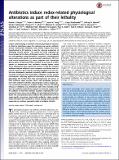Antibiotics induce redox-related physiological alterations as part of their lethality
Author(s)
Martell, Jeffrey Daniel; Takahashi, Noriko; Vercruysse, Maarten; Ting, Alice Y.; Walker, Graham C.; Dwyer, Daniel J.; Belenky, Peter A.; Yang, Jason H.; MacDonald, I. Cody; Chan, Tsz Yan Clement; Lobritz, Michael A.; Braff, Dana; Schwarz, Eric G.; Ye, Jonathan D.; Pati, Mekhala; Ralifo, Paul S.; Allison, Kyle R.; Khalil, Ahmad S.; Collins, James J.; ... Show more Show less
DownloadDwyer-2014-Antibiotics induce r.pdf (1.349Mb)
PUBLISHER_POLICY
Publisher Policy
Article is made available in accordance with the publisher's policy and may be subject to US copyright law. Please refer to the publisher's site for terms of use.
Terms of use
Metadata
Show full item recordAbstract
Deeper understanding of antibiotic-induced physiological responses is critical to identifying means for enhancing our current antibiotic arsenal. Bactericidal antibiotics with diverse targets have been hypothesized to kill bacteria, in part by inducing production of damaging reactive species. This notion has been supported by many groups but has been challenged recently. Here we robustly test the hypothesis using biochemical, enzymatic, and biophysical assays along with genetic and phenotypic experiments. We first used a novel intracellular H2O2 sensor, together with a chemically diverse panel of fluorescent dyes sensitive to an array of reactive species to demonstrate that antibiotics broadly induce redox stress. Subsequent gene-expression analyses reveal that complex antibiotic-induced oxidative stress responses are distinct from canonical responses generated by supraphysiological levels of H2O2. We next developed a method to quantify cellular respiration dynamically and found that bactericidal antibiotics elevate oxygen consumption, indicating significant alterations to bacterial redox physiology. We further show that overexpression of catalase or DNA mismatch repair enzyme, MutS, and antioxidant pretreatment limit antibiotic lethality, indicating that reactive oxygen species causatively contribute to antibiotic killing. Critically, the killing efficacy of antibiotics was diminished under strict anaerobic conditions but could be enhanced by exposure to molecular oxygen or by the addition of alternative electron acceptors, indicating that environmental factors play a role in killing cells physiologically primed for death. This work provides direct evidence that, downstream of their target-specific interactions, bactericidal antibiotics induce complex redox alterations that contribute to cellular damage and death, thus supporting an evolving, expanded model of antibiotic lethality.
Date issued
2014-05Department
Massachusetts Institute of Technology. Department of Biology; Massachusetts Institute of Technology. Department of ChemistryJournal
Proceedings of the National Academy of Sciences of the United States of America
Publisher
National Academy of Sciences (U.S.)
Citation
Dwyer, D. J., P. A. Belenky, J. H. Yang, I. C. MacDonald, J. D. Martell, N. Takahashi, C. T. Y. Chan, et al. “Antibiotics Induce Redox-Related Physiological Alterations as Part of Their Lethality.” Proceedings of the National Academy of Sciences 111, no. 20 (May 6, 2014): E2100–E2109. © National Academy of Sciences
Version: Final published version
ISSN
0027-8424
1091-6490